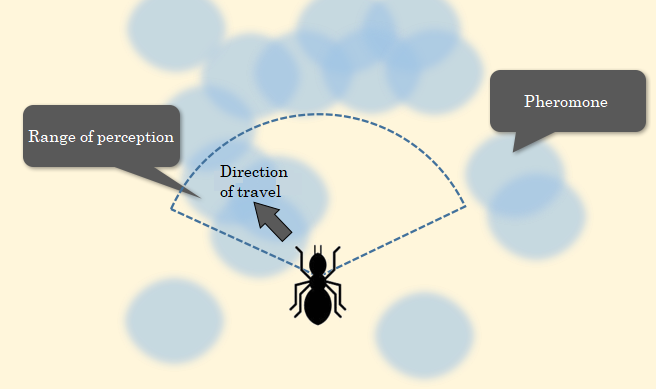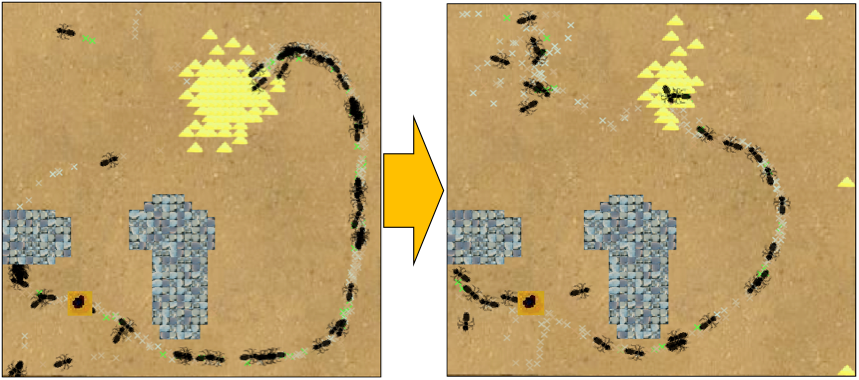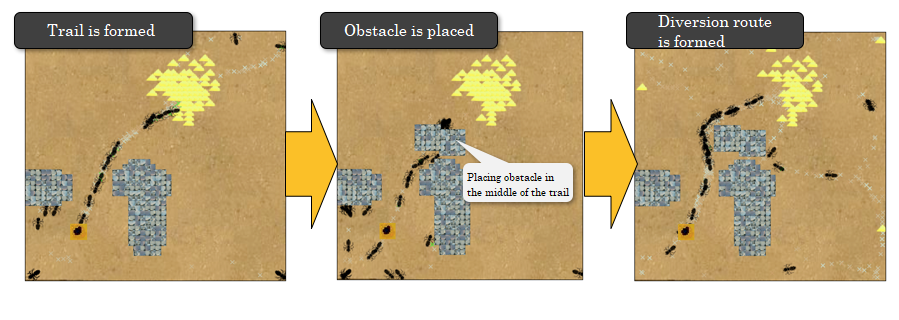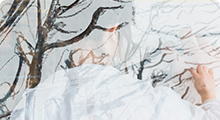MAS models
Ant trail model
Why do ants create trails?
It is likely that you have seen ants creating trails in gardens and parks. They often make trails inside the house as well. Why do ants create trails?

Ants have poor eyesight. For that reason, ants use scent to communicate with each other, rather than vision. Ants create a variety of pheromones, which are substances that produce scent, and use them to notify other ants of food, approaching danger, and so on.
When ants find a pheromone notifying them of food in the surrounding area, they move in that direction. By following the pheromone in the direction that it is strongest, they eventually make their way to the food. Ants that have come across food return to the nest leaving a trail of pheromones on the ground to notify others of the presence of food. As this process is repeated, a dense path of pheromones is gradually created, and when many ants follow this path, a trail is made.

Using simulation to reproduce the process by which a trail appears
We will use simulation to reproduce the process by which ants move from a situation in which no ants are aware of the location of food, to a situation in which a trail has been made.
The ant behavioral model is defined as follows. Furthermore, in order to simplify the model only one type of pheromone is used. Also, we limit the range at which an ant can perceive pheromones.
① When seeking food
・ If there are no pheromones in the surrounding area, move in a random direction.
・ If there are pheromones in the surrounding area, move in the direction that the pheromones are strongest.
・In order not to forget the route home, leave small amounts of pheromone on the ground.
・If an obstacle is encountered, change direction.
② When food is found
・Pick up the food and turn 180 degrees (turn to face the direction from which you came).
③ When food is being carried
・If there are no pheromones in the surrounding area, move in a random direction.
・If there are pheromones in the surrounding area, move in the direction that the pheromones are strongest.
・In order to notify others of the food, leave large amounts of pheromone on the ground.
・If an obstacle is encountered, change direction.
・If the nest is in the surrounding area, enter the nest.
・We load the above model into the simulation and execute it.
artisoc or artisoc player (free) is required to execute the model.
A short while after the simulation has been executed, a trail will appear. The trail should appear in a different way each time the simulation is executed. Try it several times to see for yourself.
Finding the shortest path to the food
An ant trail that has only just been established will not necessarily take the shortest path between the nest and the food. However, as time passes within the simulation, the trail gradually changes to link the nest and the food by the shortest distance. Why is this?

Ants move in the direction of the most pheromone they can perceive within the surrounding area. For this reason, they move along the inside of curves. Because the pheromone is volatile, if more ants do not pass along the route in a short time, it will disappear. Accordingly, the curved portion of the pheromone path gradually moves from being the outer curve to the inner curve, and becomes dead straight. The result of this is that ants can collect food efficiently moving over short distances. The speed with which this trail changes depends on the range at which ants can perceive pheromones, and the speed with which the pheromone volatilizes. Try altering these parameters and observe how they change the trail.
Control panel parameters
・ Volatilization step
Pheromones volatilize over time and become fainter, disappearing completely after a while. This is where we set the time taken to volatilize.
・Range of perception
This is where we specify the range at which an ant can perceive pheromones. The greater the range at which an ant can perceive pheromones, the further the distance at which they can be found.
Placing an obstacle in the middle of a trail
You yourself may have placed an obstacle on an ant trail, or obstructed it in some way, in real life. When an obstacle suddenly appears and causes ants to lose the pheromone path, they become flustered, but before long a trail that diverts around the obstacle will be created. Using this ant model simulation also allows us to see how a diversion route is created.

Control panel parameters
・Manual placement
Select in order to place the object manually. You can choose from Stone (large, medium, small), and Food (large, medium, small). When the map is clicked, the selected item will be placed at that location on the map.
References
[1]. Katsuhiro Nishinari “Kuruma no Jutai, Ari no Gyoretsu - Jutaigaku ga Oshieru ‘Konzatsu’ no Shinso”, Gijutsu-Hyohron Co., Ltd., 2007
|
Ant trail model basic information [Model title]: Ant trail model[Model designer]: KOZO KEIKAKU ENGINEERING Inc., Toshikatsu Mori [artisoc sample model creation]: KOZO KEIKAKU ENGINEERING Inc., Toshikatsu Mori (original), Keiichi Yashiro, Taichi Shimura (artisoc version) [artisoc sample model creation date]: Original: February 2003 artisoc version: September 2010 |



